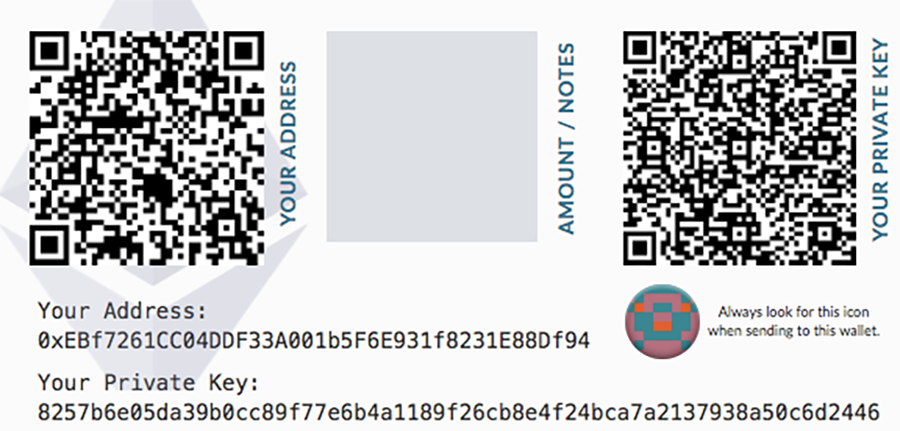
Apparently, all users of cryptocurrency have heard of such a way of storing coins as a paper crypto wallet, but it is unlikely that majority of them understand why it is needed and how it is used. Meanwhile, this is an extremely useful and even indispensable thing in some cases. We hope that after reading this article you will gain sufficient competence in this matter. Below in the article you can read instructions for ETC wallet.
Paper wallet: appearance and properties
A paper wallet is a “cold”, i.e. offline way of storing cryptocurrency: paper with information printed on it, which gives the owner access to their crypto-assets.
The paper version of cryptocurrency storage is one of the safest. The principle of cryptocurrency allows you to save money in the form of a sheet with private and public access keys. It is technically impossible to break a wallet: it is only in the hands of the owner, and the only way to steal your cryptocurrencies is to gain access to a physical storage medium, i.e. a paper wallet.
Visually, a paper wallet can look like this:

Black and white squares – QR-codes with encrypted access keys. This is an optical label that is recognized by any smartphone using special software. They contain the necessary information: a private key to access the cryptocurrency and a public address for transactions with other users.
And if the public address is intended to be transferred to other users, the private key in any form should not know anyone but the owner of the wallet: it gives access to the wallet, and, accordingly, to all transactions with cash in the account.
What do you need a paper wallet for?
At first glance, an e-wallet is not a very necessary thing, because there are software and hardware wallets. But this is not the case. Thanks to the paper wallet, it is possible to receive a cryptocurrency payment even without a laptop or smartphone. You can also quickly get your money from any device. This way, with just a sheet of paper, you will retain control over your coins.
Now let’s see how it works on the example of the coin Ethereum Classic (ETC), because it is very popular, but, unlike Ethereum, a working manual for creating a paper wallet for it is very difficult to find.
How to create an ETC wallet?
To start, we need a PC or smartphone with Internet access, a printer and a paper. Your printer had better not be connected to a WAN.
There are manuals on the Web that explain how to create a paper wallet for Ethereum Classic using the official Ethereum wallet MyEtherWallet, but now they have lost relevance because this service has stopped working with ETC.
Now you need to use the web wallet: https://ethereumclassicwallet.com/, designed to work specifically with the Ethereum Classic. It allows you to quickly create a paper ETC wallet by following a few simple steps:
- Go to the above resource. If you already have an ETC wallet, click: Unlock Wallet. Log in to your ETC wallet using one of the methods offered on the site. (If not, you must first create a wallet by clicking Create Wallet and following the instructions below).
- In the wallet interface, click the Info icon.
- Use your browser tools to take a screenshot of the data that appears in the pop-up window.
- Save and, if necessary, print the resulting image.
As a result, you should get:

Important: keep your private key secret, unlike a public address, no one but you should see it! (The image above contains data from an existing zero-balance ETC wallet created for demonstration purposes only).
How to get access to your ETC coins with a paper wallet?
With a paper wallet, you can manage your money from any device, such as a newly purchased smartphone.
This requires:
- Install an application from one of the multi-currency wallets that support ETC, such as Trust Wallet.
- Select the ETC currency to create a wallet.
- Select the I already have a wallet option.
- Import a private key using a QR scanner.
That’s all! You have gained access to your existing ETC wallet and, accordingly, the funds on it on your new device.
What cryptocurrencies can be stored on a paper wallet?
Almost every coin can be stored this way. Bitcoin, all its forks (Gold, Diamond, Cash), Ethereum, Ripple, Monero, Litecoin and other key cryptocurrencies can be stored on paper wallets. The process of creating a wallet may be different from what was shown above, but the general logic of working with paper wallets will remain the same.
Comparison with hardware devices
The key advantage of a paper wallet is security. Your money will not be stolen by hackers, unless they break into your house and steal the key papers. In fact, you own cryptocurrencies physically.
A paper wallet is a so-called “cold” method of storage, the essence of which is that the private key is stored offline.
Paper wallets are one of the best ways to store a large number of cryptocurrencies, along with other “cold” storage options – hardware. This is primarily Trezor, Ledger Nano. When using them, access to the wallet and all operations with cryptocurrencies are performed inside a physical device, this is the difference between hardware storage.
A significant advantage of hardware storage methods: the private access key is not removed and generated inside the device. Accordingly, all transactions take place between wallets, only the electronic signature of the transaction interacts with the Internet. But the hardware storage method is significantly more expensive than a paper wallet: prices for the most popular models start at $ 70.

Be the first to comment